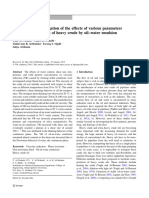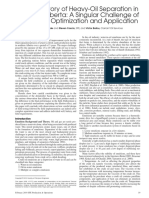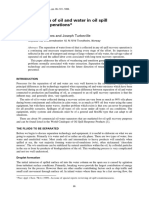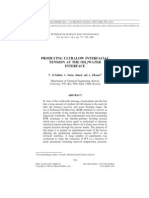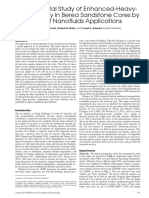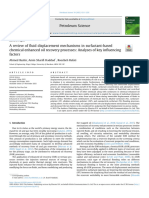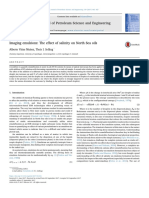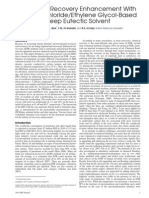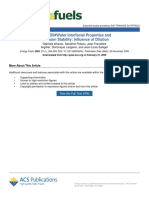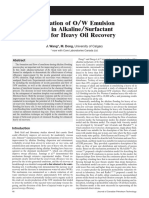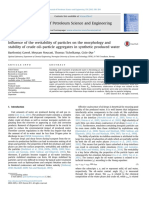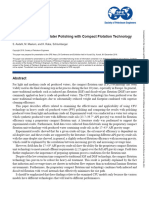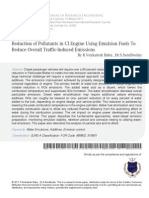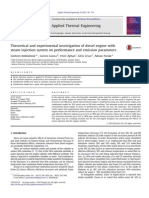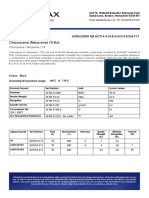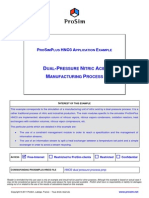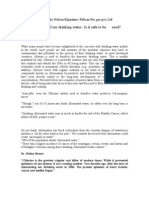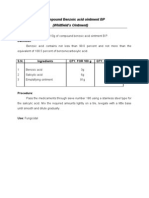Stability Behavior of Water-in-Diesel Fuel Emulsion: M. T. Ghannam and M. Y. E. Selim
Stability Behavior of Water-in-Diesel Fuel Emulsion: M. T. Ghannam and M. Y. E. Selim
Uploaded by
dipali2229Original Description:
Original Title
Copyright
Available Formats
Share this document
Did you find this document useful?
Is this content inappropriate?
Report this DocumentCopyright:
Available Formats
Stability Behavior of Water-in-Diesel Fuel Emulsion: M. T. Ghannam and M. Y. E. Selim
Stability Behavior of Water-in-Diesel Fuel Emulsion: M. T. Ghannam and M. Y. E. Selim
Uploaded by
dipali2229Copyright:
Available Formats
Petroleum Science and Technology, 27:396411, 2009
Copyright Taylor & Francis Group, LLC
ISSN: 1091-6466 print/1532-2459 online
DOI: 10.1080/10916460701783969
Stability Behavior of Water-in-Diesel
Fuel Emulsion
M. T. Ghannam
1
and M. Y. E. Selim
2
1
Department of Chemical and Petroleum Engineering
2
Department of Mechanical Engineering, College of Engineering,
United Arab Emirates University, Al-Ain, United Arab Emirates
Abstract: The presence of water within diesel fuel in the form of water-in-diesel
(W/D) emulsion lowers the pollution level of nitrogen oxides and particulate matter.
Emulsion of W/D was prepared by high-speed mixing and gradually adding water
into the diesel fuel containing a small amount of emulsied agent. We measured
the physical properties of diesel fuel and W/D emulsions with a pycnometer for
density, Fann V.G. rotational viscometer (Chandler Engineering, Model 3500, Tulsa,
Oklahoma, USA) for viscosity, and a Fisher Surface Tensiomat (Fisher Scientic
Co., Model 21, Hampton, New Hampshire, USA) for surface tension. We used a
computer image analyzer system to investigate the water droplet fuel interaction and
the water droplet distribution within the diesel phase. The results of this study show
that the emulsions of 10% and 20% W/D were stabilized for 4 weeks and 10 days,
respectively, under the conditions of 0.2% surfactant, 15,000 rpm, and 2 minutes of
mixing time. Under the same conditions, the stability period is limited to 5 hours
for emulsions with a water concentration higher than 20%. An optimum surfactant
concentration of 2% was found for 40% W/D due to the polydispersity behavior
of the added surfactant. The water droplet distribution and average diameter were
signicantly affected by the total number of mixing revolutions. We measured and
investigated the physical properties of the stable W/D emulsions in terms of density,
surface tension, and viscosity.
Keywords: combustion, mixing, stability, surfactant, water-in-diesel emulsion
INTRODUCTION
Because of several advantages, diesel engines play an important role in
modern technology. Two of these advantages are high thermal efciency
Address correspondence to M. T. Ghannam, Department of Chemical and
Petroleum Engineering, United Arab Emirates University, PO Box 17555 Al-Ain,
United Arab Emirates. Email: mamdouh.ghannam@uaeu.ac.ae
396
W/D Emulsion Stability Behavior 397
and fuel economy. Diesel engines are extensively used as power sources for
numerous industrial and civilian applications. Typical examples of these are
power plants, hospitals, marine, land, and rail transportation. However, the
exhaust gas emissions of diesel engines have been considered a very serious
issue regarding air quality and the environment. The main pollutants produced
from the exhaust of diesel engines are nitrogen oxides (NO
x
), particulate
matter, black smoke, carbon monoxide, and carbon dioxide. The presence
of these pollutants within the atmosphere will cause serious damages to the
environment such as the green house effect, acid rain, and destruction of the
ozone layer (Lin and Pan, 2001). Due to enforced environmental regulations,
reducing exhaust gas emissions from diesel engines is necessary. NO
x
and
particulate matter emissions, for example, cause serious problems in urban
environments where trafc congestion is very heavy. Several researchers have
shown that introducing water into diesel fuel to produce emulsied diesel
fuel can signicantly lower the pollution level of particulate matter and NO
x
(Muzio and Quartucy, 1997; Joshi and Pegg, 2007).
The presence of the dispersed water droplet phase within a continuous
diesel fuel phase leads to the formation of water-in-diesel emulsion (W/D
emulsion) or, in general, water-in-oil emulsion (W/O emulsion). Numerous
industrial and environmental applications involve W/O emulsions. Some ex-
amples of these applications are crude oil spillage (Mingyuan, Christy, and
Sjoblom, 1992), pipeline transportation of water in heavy crude oil (Pilehvari,
Saadevandi, Halvaci, and Clark, 1988), and crude oilpolymer emulsion
production during the enhanced oil recovery stage (Ghannam, 2003). There
are several other important industries that involve the production of stable
emulsions such as the food industries (e.g., mayonnaise), detergency (e.g.,
removal of oil deposits), pharmacy (e.g., drug emulsions), and cosmetics
(e.g., skin lotion).
The presence of surface-active material is very much needed in the
formation of W/D emulsion. The surface-active materials rst role is to
lower the interfacial tension between the water phase and the diesel fuel
phase (i.e., formation of W/D emulsion). The second role is to stabilize the
status of the water droplet phase within the diesel fuel phase to avoid the
coalescence mechanism of the water phase (Sherman, 1983). Surface-active
material accumulates at the interfacial lm between the water droplet phase
and the diesel fuel continuous phase to stabilize the water droplet phase and
consequently stabilize the emulsion. If the concentration of emulsied agent
material is reasonably high, the merging of water droplets will be prevented
(Canevari, 1987; Christopher, 1993; Eley, Hey, Symonds, and Willison, 1976;
Fingas, Fieldhouse, and Mullin, 1995).
Muzio and Quartucy (1997) attributed the formation of NO
x
to the
presence of nitrogen within the diesel fuel, excess oxygen, and high gas
combustion temperature. When water is added into the diesel fuel in the
form of W/D emulsion, however, the W/D emulsion fuel produces less NO
x
emission than the nonemulsion diesel fuel. The emulsion with 20% water
398 M. T. Ghannam and M. Y. E. Selim
content reduced NO
x
emission by 56.8% (Lin and Wang, 2004). According
to Lin and Wang (2004), during the combustion process of W/D emulsion,
it is atomized into numerous liquid droplets through a nozzle. Because the
waters boiling point is less than that of diesel fuel, the water-enveloped
layer explodes through the outer oil layer. As a result of microexplosion
behavior, the atomized emulsion drops are further atomized into much ner
droplets. This mechanism of microexplosion leads to a stronger mixing and
a faster reaction rate between the atomized fuel droplets and the surrounding
air. Therefore, a higher extent of combustion is completed. In addition,
the emission of NO
x
, particulate matter, and smoke is signicantly reduced
(Adiga and Shaw, 1990; Wang and Law, 1985).
The objective of the current study was to investigate the effect of vari-
ous factors (water concentration, surfactant concentration, mixing time, and
speed) on the stability behavior of W/D fuel emulsion.
EXPERIMENT
The main criterion for a stable emulsion is the presence of only one phase.
If more than one layer is found, it must be considered to be an unstable
emulsion. We investigated several parameters in this study. It is important
to determine the operating conditions required to maintain a stable W/D
emulsion for a reasonable period of time to cover the different stages of
preparation, storage, transportation, and consumption. We prepared a W/D
emulsion by high-speed mixing and gradually adding certain amounts of
water into the diesel fuel, which contained different amounts of surfactant
material. The amount of water varied from 0% to 50% by volume. A W/D
emulsion of 250 mL was prepared in a mixing container using a laboratory
high-speed mixer. Several mixing speeds of different mixing times were
examined to prepare the W/D emulsions. The prepared samples of emulsion
were placed into graduated glass cone containers to measure the amount of
water separated over time.
We used basic diesel fuel from the Abu Dhabi National Oil Company,
United Arab Emirates in all of the W/D emulsion investigations. Table 1
shows the physical properties of regular diesel fuel that was used. Density,
viscosity, and surface tension of diesel fuel and W/D emulsions were mea-
sured by pycnometer, Fann V.G. rotational viscometer, and the Fisher Surface
Tensiomat based on du Nouy ring principle, respectively.
W/D emulsion can be obtained by mixing the two immiscible uids
in the presence of a surfactant. The dispersion mechanism produces a very
small water droplet phase dispersed within the diesel continuous phase. The
surfactant added to the mixture reduces the interfacial tension between the
water and the diesel to produce the emulsion and to stabilize the water droplet
phase within the continuous phase of diesel fuel. We used nonionic surfactant
of Triton X-100 (iso-octylphenoxypolyethoxy ethanol; BDH Middle East
W/D Emulsion Stability Behavior 399
L.L.C., United Arab Emirates) as an emulsifying agent. A wide range of
surfactant concentrations of 0% to 5% by volume was covered in this study.
We prepared the W/D emulsion by using a Silent Crusher M homogenizer
(Heidolph Instruments GmbH & Co KG, Schwabach, Germany) over the
range of 5,000 to 26,000 rpm. A Zeiss optical microscope (Kontron Elek-
tronik, Essen, Germany) was used to examine the emulsion characteristics,
droplet distribution, and water-diesel fuel interaction. We used a computer
image analyzer system (Kontron Elektronik, Essen, Germany) to study the
emulsion. This system consists of a high-resolution video camera mounted
on an optical polarizing microscope, an image processor, a Pentium PC
(Kontron Elektronik, Essen, Germany), and a high-resolution image monitor.
In addition, the computer image analyzer system has a powerful facility to
enhance the captured image in terms of sharpening, edge detection, threshold
function, transition lter, chord sizing, and dilation.
RESULTS AND DISCUSSION
We investigated the stability of W/D emulsion under the inuence of the
water concentration, surfactant concentration, mixing speed, and time.
Stability Investigation
We studied a wide range of water concentration in this investigation from 0%
to 50% by volume in 10% increments. The percentage of water separated
by volume versus the elapsed time is measured for each sample of W/D
emulsion. The percentage of water separated can be calculated from:
% water separated D .H
2
O/
i
.H
2
O/
f
100=.H
2
O/
i
(1)
In this equation, (H
2
O)
i
is the initial water content, and (H
2
O)
f
is the nal
water content. As a preliminary observation, a 20% W/D emulsion was
prepared with no added surfactant, a mixing period of 3 minutes, and a mixing
speed of 15,000 rpm. We observed that the percentage of water separated is
Table 1. Physical properties of Abu Dhabi
National Oil Company diesel fuel
Density at 20
C, kg/m
3
829.7
Dynamic viscosity at 20
C, mPas 5.61
Surface tension at 20
C, mN/m 30.5
Flash point,
C 76
Initial boiling point,
C 169.8
Final boiling point,
C 376.5
400 M. T. Ghannam and M. Y. E. Selim
80% at elapsed time equals zero, that is, when the homogenizer was ceased.
We only needed 5 minutes to separate the entire amount of introduced water.
Even higher mixing speeds of 60,000 rpm over 3 minutes of mixing did
not enhance the emulsion stability. We prepared another run for 20% W/D
emulsion using a mixing speed of 20,000 rpm, no added surfactant, and
a mixing period of 30 minutes. This test showed that almost 90% of the
introduced water was separated within the rst 10 minutes of elapsed time.
Therefore, this preliminary study showed that the presence of surfactant is
crucial for W/D emulsion stability. Figure 1 shows the effect of added water
on the emulsion stability in the presence of 0.2% surfactant concentration.
We prepared the emulsions using a mixing speed of 15,000 rpm and mixed
for 2 minutes. Figure 1 shows that the 10% W/D emulsion remained stable
for almost 4 weeks without any separated water. The 20% W/D remained
stable for 10 days before any water was separated. The stability prole
of 30%, 40%, and 50% W/D emulsions is also shown in Figure 1. The
last three emulsions remained stable for only 5 hours, and then the water
gradually separated from the emulsion. As can be seen, the percentage of
water separated gradually increased with the water concentration. In the 50%
W/D emulsion, for example, 67% of the introduced water was separated
within 3.8 days. Figure 1 shows the importance of the surfactants role on
the W/D emulsion stability.
It is important to determine the stability conditions for each W/D emul-
sion in terms of mixing speed, mixing time, and surfactant concentration.
Figure 2 shows the stability prole for 20% W/D emulsion. This emulsion
was prepared in the presence of 0.2% surfactant concentration, mixed for
2 minutes, and different mixing speeds ranging from 5,000 rpm to 15,000
Figure 1. Stability prole for different W/D emulsions.
W/D Emulsion Stability Behavior 401
Figure 2. Effect of mixing speed on the stability behavior of 20% W/D emulsion.
rpm. As can be concluded from Figure 2, the emulsion remained stable for
almost 6.5 hours without separating any water under all the reported mixing
speeds. Beyond this period, the stability enhanced strongly with mixing speed.
For example, the 20% W/D emulsion was reported stable for 10 days when
a 15,000-rpm mixing speed was applied. For a longer stable period, the 20%
W/D emulsion can be prepared in the presence of 1% surfactant concentration,
10-minute mixing time, and 15,000 rpm. These conditions provided a stable
period of 4 weeks as shown in Figure 2.
The stability investigation for the 30% W/D emulsion was carried out
using a mixing speed of 15,000 rpm, 0.2% surfactant concentration, and a
mixing time of 2 minutes. The 30% emulsion was only stable for 5 hours.
The water was gradually separated until 32% of the water separated within
1 week. As higher mixing times of 10 and 20 minutes were examined, the
stability prole was slightly enhanced. For 20 minutes of mixing time, the
emulsion was stable for 8.5 hours, and 11% of the water was separated within
1 week as shown in Figure 3a. In order to enhance the stability behavior of
30% W/D emulsion signicantly, we added several surfactant concentrations
over the range of 0.2 to 1.75% for a mixing speed of 20,000 rpm and a
mixing time of 30 minutes (Figure 3b). The presence of surfactant shows a
strong effect on the emulsion stability enhancement. As can be concluded
from Figure 3b, the amount of water separated from the emulsion strongly
decreased with the increase of surfactant concentration. For example, at the
surfactant concentration of 1.75%, the 30% W/D emulsion remained stable
for almost 1 week.
We prepared the 40% W/D emulsion under similar previous conditions of
20,000 rpm mixing speed, 30 minutes of mixing time, and several surfactant
402 M. T. Ghannam and M. Y. E. Selim
(a)
Figure 3a. Stability prole of 30% W/D emulsion for different mixing time.
(b)
Figure 3b. Stability prole of 30% W/D emulsion for different surfactant concentra-
tion.
W/D Emulsion Stability Behavior 403
concentrations ranging from 0.25 to 5%. In the presence of 0.25% surfactant,
the emulsion was only stable for 1 hour, and then the percentage of water
separated increased gradually until 45% of the water was separated within
1 week. As mentioned previously, the addition of up to 2% surfactant con-
centration signicantly enhanced the stability performance. In the presence
of 2% surfactant, the 40% emulsion was stable for 4 hours and only 10% of
the water separated within 1 week. Adding more surfactant will change its
behavior and negatively affect the emulsion stability due to the polydispersity
effect of surfactant micelles formed at the water-diesel interface as noted in
Figure 4 for the 3% and 5% surfactant behaviors (Wasa, Nikolou, and Ainetti,
2004). This means that there is an optimum concentration of added surfactant
to enhance the stability behavior for W/D emulsions.
We carried out the emulsication process at room temperature using
a homogenizing unit to prepare a stable W/D emulsion to produce a low
cost and stable emulsion for at least 1 week. The formation of the W/D
emulsion is signicantly affected by the method used to mix the emulsion
components together. We recommend from experience that the water phase
should be added gradually into the mixing material of the diesel phase with an
emulsier. The surfactants role is complicated but crucial. For the surfactant
to be effective, it must be transported to the W/D interface where it is
absorbed and forms a surface layer. This migration is accelerated by intense
mixing. This mechanism produces a stable emulsion of the water droplet
phase within the continuous diesel phase (i.e., W/D emulsion). The stability
of water droplets within the emulsion depends on two competitive factors:
(a) the presence of the emulsier material around all the droplets surfaces to
stabilize the W/D emulsion and (b) the droplets coalescence mechanism
Figure 4. Effect of surfactant concentration on 40% W/D emulsion.
404 M. T. Ghannam and M. Y. E. Selim
to destabilize the emulsion. For the destabilization of W/D emulsion to
occur, the water droplet phase goes through several steps before the complete
separation of the water phase from the W/D emulsion. If the repulsive forces
between droplets are too weak, droplets move to each other. The single
droplets are replaced by multiple droplets separated by a thin lm (i.e.,
occulation process). The thin-lm thickness is reduced by the Van der Waals
attraction forces. Once the lm thickness reduces to a critical value, the lm
breaks suddenly to form a larger droplet (i.e., coalescence process). Once the
coalescence process has started, the water droplets will settle to the bottom
due to the density difference (i.e., sedimentation process). Both occulation
and coalescence processes lead to larger droplets until the complete phase of
separation occurs (Sherman, 1983).
Water Droplet Distribution
Using the computer image analyzer system, we investigated several W/D
emulsions with different water concentrations. Among numerous tested sam-
ples in terms of stability behavior, we decided to investigate the best stable
samples for each water concentration and tested six samples of W/D emul-
sions over the water concentration range of 10 to 50%. Table 2 shows the
preparation conditions and stability period for each sample.
For the 10/90 W/D emulsion sample, Table 2 shows that the preparation
conditions of 30,000 revolutions and 0.2 wt% surfactant were enough to
produce stable emulsion for 4 weeks. For a higher concentration of wa-
ter content, the total number of revolutions and/or surfactant concentration
should be increased signicantly to obtain a stable emulsion. Stability can
be improved even more through the conditions that avoid the coalescence
mechanism of small water droplets, whereas coalescence will produce larger
water droplets and eventually lead to an unstable W/D emulsion. The smaller
the droplets are, the more intense the agitation should be to disrupt them.
The water droplet distribution analysis for each investigated emulsion is
Table 2. Preparing conditions for stable W/D emulsions
W/D
Emulsion
Speed
rpm
Mixing time
minutes
Surfactant
%
Stable
period
10/90 15,000 2 0.2 4 weeks
20/80 15,000 10 0.2 10 days
20/80 15,000 10 1.0 4 weeks
30/70 20,000 30 1.7 1 week
40/60 20,000 30 2.0 4 hours
50/50 20,000 30 2.0 1 hour
W/D Emulsion Stability Behavior 405
Figure 5. Droplet diameter distribution for different emulsions.
displayed in Figure 5. It shows that the water droplet distribution decreased
gradually over the water concentration range of 10 to 30% because of the
signicant increase in the total number of mixing revolutions and therefore
produced smaller diameters of water droplets. Figure 5 shows that if there is
any further addition of water concentration beyond 30%, the water droplets
distribution slightly increases, producing larger diameters of water droplets.
This change can be attributed to the use of the same total number of mixing
revolutions for the 30%, 40% and 50% water concentrations as listed in
Table 2. The Sautor mean droplet diameter (D
sv
; equation 2) was used
to measure the average diameter of the water droplets for each emulsion
(Sherman, 1983; Table 3). The size distribution of water droplets within
the W/D emulsion samples listed in Table 2 was observed by the com-
puter image analyzer system. Figure 6 shows typical examples of water
droplet distribution within different W/D emulsions for different water con-
centrations.
D
sv
D
X
N
i
D
3
i
.
X
N
i
D
2
i
(2)
in which N
i
is the number of water droplets and D
i
is the droplet diameter.
Table 3. Average diameter of water droplets
W/D Emulsion 10/90 20/80 30/70 40/60 50/50
D
sv
, m 4.24 3.71 1.70 2.25 2.62
406 M. T. Ghannam and M. Y. E. Selim
Figure 6. Photomicrographs of 10/90, 30/70, and 50/50 emulsions.
W/D Emulsion Stability Behavior 407
Table 4. Density and surface tension at 20
C
W/D
Emulsion
Density,
kg/m
3
Surface tension,
mN/m
10/90 835 44.0
20/80 846 42.5
30/70 875.2 41.0
Emulsion Physical Properties
It is important to investigate the physical properties of W/D emulsions to
assess the role of the water presence within the diesel emulsions and the
interaction between the water droplet phase and the diesel continuous phase.
These properties are density, viscosity, and surface tension. Table 4 reports
the density and surface tension for the stable tested emulsions at 20
C.
Because the emulsion preparation, storage, and transportation can be
carried out at different temperatures, it is important to study the effect of
temperature on the density and viscosity of the stable W/D emulsions. The
effect of temperature on emulsion density is displayed in Figure 7a over the
temperature range of 20
C to 60
C. In Figure 7a, over the water concentration
range of 0 to 30%, the density of the emulsion increases signicantly with
water addition. For the water concentration of 0 to 20%, temperature shows
a slight effect on the reduction of the emulsion density. For the emulsion
of 30/70, however, the density decreases signicantly with temperature. To
investigate the emulsion viscosity, we used the Fann V-G concentric alignment
cylindrical rotational viscometer for all test measurements. This concentric
cylindrical-type viscometer generates shear rate range of three cycles over
1 to 1000 s
1
. We studied the effects of temperature over the range of 20
C
to 60
C and shear rate over the range of 1 to 1000 s
1
for all samples of
stable emulsions. Pure diesel fuel shows Newtonian behavior versus shear
rate and signicantly decreases with temperature (Joshi and Pegg, 2007).
Table 5 shows the viscosity measurements as a function of temperature for
pure diesel fuel. Figure 7b shows typical examples of the rheogram behaviors
in terms of viscosity , Pas, versus shear rate P , and s
1
, at 20
C for different
stable emulsions. All the tested emulsions showed strong non-Newtonian
behavior (called yield-pseudoplastic) of shear thinning with a yield stress.
Figure 7b shows a strong viscosity reduction with a shear rate for all tested
emulsions at 20
C. The ow behavior presented in Figure 7b can be divided
into two main regionsthe low shear rate region and the high shear rate
region. At the low shear rate region, the emulsion viscosity was strongly
shear dependent providing pseudoplastic behavior. On the other hand, at the
high shear rate, all viscosity curves approaching each other provided a low
408 M. T. Ghannam and M. Y. E. Selim
(a)
Figure 7a. Effect of temperature on W/D emulsions.
Table 5. Viscosity of diesel fuel
Temperature,
C 20 30 40 50 60
Viscosity, mPas 5.61 4.25 3.65 3.12 2.52
(b)
Figure 7b. Viscosity-shear rate relation for W/D emulsions.
W/D Emulsion Stability Behavior 409
viscosity value. Therefore, the viscosity becomes shear rate independent at a
very high shear rate (i.e., Newtonian ow behavior). In addition, the results
show the emulsion viscosity decreased signicantly with temperature over
the range of 20
C to 60
C. Kerihuel, Kumar, Bellettre, and Tazerout (2006)
showed strong non-Newtonian shear thinning ow behavior for methanol
emulsion used as a diesel engine fuel over the shear rate of 0 to 1200 s
1
at
30
C.
The Herschel-Bulkley model (equation 3) can be used to model the
ow behavior (Chhabra and Richardson, 1999) in which
o
is the appar-
ent yield stress in Pa, P is the corresponding shear rate in s
1
, m is the
consistency index Pas
n
, and n is the ow behavior index that is dimen-
sionless. Modeling analysis according to equation 3 is carried out for all
the stable emulsions at different temperatures from 20
C to 60
C. Table 6
shows the yield stress values, consistency index (m), and ow behavior
index (n), respectively. It is well known that the mechanical properties of
structured liquids modify strongly over a narrow low range of stress level.
Below this stress level, the material deforms elastically with nite rigidity
to show solid-like behavior. Above this stress level, the material shows con-
tinuous deformation to observe viscous liquid-like behavior. The stress level
at this transition stage is known as apparent yield stress. The yield stress
directly inuences the initiation of an emulsion ow from a container by
pumping the emulsion into a transportation pipeline. The values of
o
, m,
and n are signicantly dependent on emulsion composition and temperature
(Table 6).
D
o
CmP
n
(3)
The modeling analysis for the yield stress .
o
), consistency index .m/; and
ow behavior index .n/ are carried out versus temperature according to equa-
tions 4, 5, and 6, respectively. The tting analysis estimates the coefcients
A and B for each stable emulsion for yield stress, consistency index, and
ow behavior index. The modeling analysis was carried out for all the stable
Table 6. Fitting parameters of equation 3
10/90 Emulsion 20/80 Emulsion 30/70 Emulsion
Temperature,
C
o
m n
o
m n
o
m n
20 15.01 10.76 0.41 13.3 5.39 0.46 3.17 1.15 0.58
30 3.42 8.42 0.40 6.32 1.48 0.52 3.44 0.65 0.63
40 3.64 4.84 0.39 5.62 1.37 0.53 3.29 0.44 0.68
50 5.19 1.06 0.55 3.02 0.28 0.72
60 5.04 0.65 0.62 2.59 0.38 0.68
410 M. T. Ghannam and M. Y. E. Selim
Table 7. Modeling analysis for
o
, m, and n
W/D
Emulsion A
1
B
1
A
2
B
2
A
3
B
3
10/90 141.9 0.113 22.60 0.036 0.483 0.055
20/80 22.1 0.031 25.83 0.081 0.221 0.243
30/70 3.9 3.17 2.51 0.041 0.348 0.176
emulsions with an average regression factor of 0.95 (Table 7).
o
D A
1
exp.B
1
T / (4)
m D A
2
exp.B
2
T / (5)
n D A
3
T
B3
(6)
CONCLUSIONS
The study of the emulsied W/D emulsion showed the following points:
1. The presence of surfactant is crucial to stabilize the W/D emulsions for a
reasonable period of time.
2. In the presence of 0.2% surfactant, 15,000 rpm, and 2 minutes of mixing
time, the 10% W/D and 20% W/D emulsions remain stable for 4 weeks
and 10 days, respectively. For higher water concentrations, however, the
stability period is limited to 5 hours.
3. To stabilize higher water concentration (i.e., >20% W/D emulsion), it is
required to increase the surfactant concentration and the total number of
mixing revolutions.
4. Due to the polydispersity effect of added surfactant, the optimum surfac-
tant concentration for 40% W/D emulsion is about 2% surfactant.
5. Water droplet distribution decreases gradually with water concentration
for 10%, 20%, and 30% W/D emulsions due to the increase of the total
number of mixing revolutions.
6. Water droplet distribution increases gradually with water concentration for
30%, 40%, and 50% W/D emulsions due to the application of the same
total number of mixing revolutions.
7. The density of W/D emulsion increases with water content. The temper-
ature has signicant inuence to lower the density of W/D emulsion.
8. All stable emulsions showed yield-pseudoplastic behavior. Strong viscosity
reduction with shear rate is reported for all stable emulsions. The Herschel-
Bulkley model can be used to simulate the ow behavior of stable W/D
emulsions.
W/D Emulsion Stability Behavior 411
REFERENCES
Adiga, K., and Shah, D. (1990). On the vaporization behavior of water-in-oil
microemulsions. Combust. Flame 80:412415.
Canevari, G. (1987). In: Proceeding of Oil Spill Conference. American Pe-
troleum Institute, Washington, DC, pp. 293296.
Chhabra, R., Richardson, J. (1999). Non-Newtonian Flow in the Process
Industries. Oxford: Butterworth-Heinemann.
Christopher, C. (1993). Formation and Breaking of Water-in-Oil Emulsions.
Washington, DC: Marine Spill Response Corporation.
Eley, D., Hey, M., Symonds, J., and Willison, J. (1976). Electron micrograph
of emulsions of water in crude petroleum. J. Colloid. Int. Sci. 54:462
466.
Fingas, M., Fieldhouse, B., and Mullin, J. (1995). In: Proceeding of Oil Spill
Conference. American Petroleum Institute, Washington, DC, pp. 829
830.
Ghannam, M. (2003). Emulsion ow behavior of crude oilalcoood poly-
mers. J. Chem. Eng. Japan 36:3544.
Joshi, R., and Pegg, M. (2007). Flow properties of biodiesel fuel blends at
low temperatures. Fuel 86:143151.
Kerihuel, A., Kumar, M., Bellettre, J., and Tazerout, M. (2006). Ethanol
animal fat emulsions as a diesel engine fuel, Part 1: Formulations and
inuential parameters. Fuel 85:26402645.
Lin, C., and Pan., J. (2001). Corrosion characteristics of furnaces burning
with emulsied diesel oil contained sodium sulfate. Corros. Prev. Control
47:8392.
Lin, C., and Wang, K. (2004). Diesel engine performance and emission
characteristics using three-phase emulsions as fuel. Fuel 83:537545.
Mingyuan, L., Christy, A., and Sjoblom, J. (1992). EmulsionsA Funda-
mental and Practical Approach. Dordrecht, The Netherlands: Kluwer
Academic.
Muzio, L., and Quartucy, G. (1997). Implementing NO
x
control: Research to
application. Prog. Energy Combustion Sci. 23:233266.
Pilehvari, A., Saadevandi, B., Halvaci, M., and Clark, D. (1988). Pipeline
transportation of heavy crude as emulsions. Proceedings of the Third
International Symposium on Liquid Solid Flows. ASME V75, New York,
pp. 161.
Sherman, P. (1983). Encyclopedia of Emulsion Technology, Becher, P. (Ed.).
Vol. 1. New York: Dekker.
Wang, C., and Law, C. (1985). Microexplosion of droplets under high pres-
sure. Combust. Flame 59:5362.
Wasa, D., Nikolou, A., and Ainetti, F. (2004). Texture and stability of emul-
sions and suspensionsrole of oscillatory structural forces. Adv. Colloids
Interface Sci. 108/109:187195.
You might also like
- Okpako Ejiroghene Proj ProposalDocument15 pagesOkpako Ejiroghene Proj Proposalokpako ejiroNo ratings yet
- Demulsification of W/O Emulsion at Petroleum Field and Reservoir Conditions Using Some Demulsifiers Based On Polyethylene and Propylene OxidesDocument11 pagesDemulsification of W/O Emulsion at Petroleum Field and Reservoir Conditions Using Some Demulsifiers Based On Polyethylene and Propylene OxidesLluísNo ratings yet
- Foaming in Micellar Solutions: E Ffects of Surfactant, Salt, and Oil ConcentrationsDocument11 pagesFoaming in Micellar Solutions: E Ffects of Surfactant, Salt, and Oil Concentrationsjulio adrian tzoni patlaniNo ratings yet
- J Ces 2018 05 033Document31 pagesJ Ces 2018 05 033RAHMANSYAH RAHMANSYAHNo ratings yet
- Energy Conversion and Management: A. Alahmer, J. Yamin, A. Sakhrieh, M.A. HamdanDocument6 pagesEnergy Conversion and Management: A. Alahmer, J. Yamin, A. Sakhrieh, M.A. Hamdandipali2229No ratings yet
- Evaluation of Nanoparticle-Stabilized Emulsion Flooding: Glass-Micromodel Experimental StudyDocument10 pagesEvaluation of Nanoparticle-Stabilized Emulsion Flooding: Glass-Micromodel Experimental StudyTASHVINDER RAONo ratings yet
- Effects of Surfactants and Alkalis On The Stability of Heavy-Oil-in-Water EmulsionsDocument10 pagesEffects of Surfactants and Alkalis On The Stability of Heavy-Oil-in-Water EmulsionsEliasNo ratings yet
- Impact of Emulsified Water/Diesel Mixture On Engine Performance and EnvironmentDocument7 pagesImpact of Emulsified Water/Diesel Mixture On Engine Performance and Environmentdipali2229No ratings yet
- Experimental Investigation of Stability of Water in Oil Emulsions at ReservoirDocument13 pagesExperimental Investigation of Stability of Water in Oil Emulsions at ReservoirNour SwamNo ratings yet
- FracturingDocument43 pagesFracturingPrincess OkolomaNo ratings yet
- Ultrasonics SonochemistryDocument6 pagesUltrasonics SonochemistryHassan TalebiNo ratings yet
- Al-Wahaibi2015 Article ExperimentalInvestigationOfTheDocument7 pagesAl-Wahaibi2015 Article ExperimentalInvestigationOfTheJesus AlbertoNo ratings yet
- Mechanistic Study of Improved Heavy Oil Recovery by Alkaline Flood and Effect of WetabilityDocument12 pagesMechanistic Study of Improved Heavy Oil Recovery by Alkaline Flood and Effect of WetabilityRosa K Chang HNo ratings yet
- SPE-176465-MS Experimental Investigation of Crude Oil Emulsion Physicochemical Properties and Demulsifier Dosage PredictionDocument24 pagesSPE-176465-MS Experimental Investigation of Crude Oil Emulsion Physicochemical Properties and Demulsifier Dosage PredictionGabriel EduardoNo ratings yet
- A Case History of Heavy-Oil Separation in Northern Alberta: A Singular Challenge of Demulsifier Optimization and ApplicationDocument6 pagesA Case History of Heavy-Oil Separation in Northern Alberta: A Singular Challenge of Demulsifier Optimization and Applicationmanuel cabarcasNo ratings yet
- (13653075 - Pure and Applied Chemistry) Separation of Oil and Water in Oil Spill Recovery OperationsDocument7 pages(13653075 - Pure and Applied Chemistry) Separation of Oil and Water in Oil Spill Recovery Operationsطائر النورسNo ratings yet
- Demulsif SaltDocument12 pagesDemulsif SaltLidiya KirilovaNo ratings yet
- Producing Ultralow Interfacial Tension at The Oil/Water InterfaceDocument16 pagesProducing Ultralow Interfacial Tension at The Oil/Water InterfaceUmmu Mus'abNo ratings yet
- Experimental Study of Enhanced-Heavy-Oil Recovery in Berea Sandstone Cores by Use of Nanofluids ApplicationsDocument13 pagesExperimental Study of Enhanced-Heavy-Oil Recovery in Berea Sandstone Cores by Use of Nanofluids ApplicationsAnand aashishNo ratings yet
- A Comprehensive Evaluation of Alkaline Surfactant Polymer Flooding and Hybrid Process For Enhanced Oil RecoveryDocument40 pagesA Comprehensive Evaluation of Alkaline Surfactant Polymer Flooding and Hybrid Process For Enhanced Oil RecoveryAsim MemonNo ratings yet
- A Review of Fluid Displacement Mechanism in Surfactant-Based CEOR ProcessesDocument25 pagesA Review of Fluid Displacement Mechanism in Surfactant-Based CEOR ProcessesrobertNo ratings yet
- Journal of Petroleum Science and Engineering: Alberto Vi Nas Mu Noz, Theis I. SøllingDocument5 pagesJournal of Petroleum Science and Engineering: Alberto Vi Nas Mu Noz, Theis I. SøllingAlexander LopezNo ratings yet
- 1 s2.0 S0045653504006630 MainDocument12 pages1 s2.0 S0045653504006630 MainNaiara KrelingNo ratings yet
- Heavy-Oil-Recovery Enhancement With Choline Chloride Ethylene Glycol-Based Deep Eutectic SolventDocument9 pagesHeavy-Oil-Recovery Enhancement With Choline Chloride Ethylene Glycol-Based Deep Eutectic Solventirfan100% (1)
- Interacción Surfactante-Polímero Sobre Las Propiedades Interfaciales de Una SustanciaDocument9 pagesInteracción Surfactante-Polímero Sobre Las Propiedades Interfaciales de Una SustanciaJesus BcNo ratings yet
- Petrol 109318Document19 pagesPetrol 109318dancelikedaveNo ratings yet
- Alade 2019Document13 pagesAlade 2019Wan Mohd Shaharizuan100% (1)
- Simulation of O/W Emulsion Flow in Alkaline/Surfactant Flood For Heavy Oil RecoveryDocument13 pagesSimulation of O/W Emulsion Flow in Alkaline/Surfactant Flood For Heavy Oil Recoverylulalala8888No ratings yet
- Heavy Oil#Water Interfacial Properties and Emulsion Stability: Influence of DilutionDocument7 pagesHeavy Oil#Water Interfacial Properties and Emulsion Stability: Influence of DilutionMohamed AuresNo ratings yet
- Simulation of O/W Emulsion Flow in Alkaline/Surfactant Flood For Heavy Oil RecoveryDocument7 pagesSimulation of O/W Emulsion Flow in Alkaline/Surfactant Flood For Heavy Oil RecoveryWilmer CuicasNo ratings yet
- Emulsification Characteristics of Three-And Two-Phase Emulsions Prepared by The Ultrasonic Emulsification MethodDocument9 pagesEmulsification Characteristics of Three-And Two-Phase Emulsions Prepared by The Ultrasonic Emulsification MethodAD OLofloveNo ratings yet
- Khamees 2018Document27 pagesKhamees 2018VeronicaNo ratings yet
- Bonilla 2013Document10 pagesBonilla 2013MaringanNo ratings yet
- SPE-182836-MS Simulation of Ionic Liquid Flooding For Chemical Enhance Oil Recovery Using CMG STARS SoftwareDocument14 pagesSPE-182836-MS Simulation of Ionic Liquid Flooding For Chemical Enhance Oil Recovery Using CMG STARS SoftwareVeronicaNo ratings yet
- Processes 10 00738 v2Document34 pagesProcesses 10 00738 v2heranNo ratings yet
- Inversion Point of Emulsions As A MechanDocument12 pagesInversion Point of Emulsions As A MechanBruce ClozzaNo ratings yet
- Water in DieselDocument14 pagesWater in Dieselnpd20micronsNo ratings yet
- 2016 Bartłomiej Gaweł, Meysam Nourani, Thomas Tichelkamp, Gisle Øye, Influence of The Wettability of ParticlesDocument3 pages2016 Bartłomiej Gaweł, Meysam Nourani, Thomas Tichelkamp, Gisle Øye, Influence of The Wettability of Particles10_DAVID_10No ratings yet
- CaracterizciónDocument7 pagesCaracterizciónandrea.cipagautaNo ratings yet
- Microemulsions A Novel Approach To Enhanced Oil Recovery A ReviewDocument15 pagesMicroemulsions A Novel Approach To Enhanced Oil Recovery A ReviewLindaNathalieSuarezPiñerezNo ratings yet
- Riazi 1Document16 pagesRiazi 1Seyedeh Maryam MousaviNo ratings yet
- Characterization of Oil-Water Emulsion and Its UseDocument7 pagesCharacterization of Oil-Water Emulsion and Its UseCamilo Bocanegra ChaparroNo ratings yet
- Modification of The Stability of Oil-In-Water Nano-Emulsions by Polymers With Different StructuresDocument10 pagesModification of The Stability of Oil-In-Water Nano-Emulsions by Polymers With Different StructuresAnand aashishNo ratings yet
- 90 IChE Salager Dehydration BasicsDocument15 pages90 IChE Salager Dehydration BasicsThiago Alejandro Villabona EstupiñanNo ratings yet
- Preparation of O/w Emulsions Stabilized by Solid Particles and Their Characterization by Oscillatory RheologyDocument10 pagesPreparation of O/w Emulsions Stabilized by Solid Particles and Their Characterization by Oscillatory RheologySylvana AlvarezNo ratings yet
- Emulsification of Heavy Crude Oil in Water For Pipeline Transportation PDFDocument7 pagesEmulsification of Heavy Crude Oil in Water For Pipeline Transportation PDFJesus AlbertoNo ratings yet
- Chemical Engineering Journal: Dariush Mowla, Gholamreza Karimi, Kobra SalehiDocument10 pagesChemical Engineering Journal: Dariush Mowla, Gholamreza Karimi, Kobra SalehiAdelina96No ratings yet
- 2008 Effect of Salinity and PH On Pickering Emulsion StabilityDocument17 pages2008 Effect of Salinity and PH On Pickering Emulsion StabilityLuis Carlos Patiño LagosNo ratings yet
- Mohajer I 2015Document47 pagesMohajer I 2015Cesar PosadaNo ratings yet
- A Novel Viscosity Reduction Plant-Based Diluent For Heavy and Extra-Heavy OilDocument15 pagesA Novel Viscosity Reduction Plant-Based Diluent For Heavy and Extra-Heavy OilTimur RegarNo ratings yet
- Prediction of Flow Behavior of Crude Oil-in-Water Emulsion Through The Pipe by Using Rheological PropertiesDocument5 pagesPrediction of Flow Behavior of Crude Oil-in-Water Emulsion Through The Pipe by Using Rheological PropertiesdrramsayNo ratings yet
- Coagulation/Flocculation Process For Produced Water TreatmentDocument5 pagesCoagulation/Flocculation Process For Produced Water TreatmentblondtumbalaNo ratings yet
- 20-80% Water-In-Diesel Emulsion Fuel Formulations and Stability Study For Duration of Two WeeksDocument5 pages20-80% Water-In-Diesel Emulsion Fuel Formulations and Stability Study For Duration of Two WeeksEvaPuspitaSariNo ratings yet
- 110428AFSWater Diesel SeparationPart2Document17 pages110428AFSWater Diesel SeparationPart2Jesse Haney IIINo ratings yet
- 06-Mechanisms of Crude Oil DemulsificationDocument10 pages06-Mechanisms of Crude Oil DemulsificationajostosNo ratings yet
- Evaluation of Stability For Flowing Water-In-Oil Emulsion in Transportation PipelineDocument15 pagesEvaluation of Stability For Flowing Water-In-Oil Emulsion in Transportation PipelineTrung Dinh DucNo ratings yet
- Polymer Surfactant Assisted EORDocument27 pagesPolymer Surfactant Assisted EORAnurag GuptaNo ratings yet
- Spe 184146 MsDocument18 pagesSpe 184146 Msluis mendozNo ratings yet
- Effect of Scale and Corrosion Inhibitors On Well Productivity inDocument10 pagesEffect of Scale and Corrosion Inhibitors On Well Productivity injose luis pachecoNo ratings yet
- Oil Spill Remediation: Colloid Chemistry-Based Principles and SolutionsFrom EverandOil Spill Remediation: Colloid Chemistry-Based Principles and SolutionsNo ratings yet
- APT Emulsion Fuels: Environmental Management PresentationDocument33 pagesAPT Emulsion Fuels: Environmental Management Presentationdipali2229No ratings yet
- Simple and Multiple Water Fuel Emulsions Preparation in Helical FlowDocument8 pagesSimple and Multiple Water Fuel Emulsions Preparation in Helical Flowdipali2229No ratings yet
- Reduction of Pollutants in CI Engine Using Emulsion Fuels To Reduce Overall Traffic-Induced EmissionsDocument7 pagesReduction of Pollutants in CI Engine Using Emulsion Fuels To Reduce Overall Traffic-Induced Emissionsdipali2229No ratings yet
- An Analysis of The Combustion Characters and The Mechanism of Oil-Consumption Economy For Diesel Engines Using Water-Blended OilDocument15 pagesAn Analysis of The Combustion Characters and The Mechanism of Oil-Consumption Economy For Diesel Engines Using Water-Blended Oildipali2229No ratings yet
- Direct Water Injection Cooling For Military E N G I N E S and Effects On The Diesel CycleDocument11 pagesDirect Water Injection Cooling For Military E N G I N E S and Effects On The Diesel Cycledipali2229No ratings yet
- Applied Thermal Engineering: Görkem Kökkülünk, Güven Gonca, Vezir Ayhan, - Idris Cesur, Adnan ParlakDocument10 pagesApplied Thermal Engineering: Görkem Kökkülünk, Güven Gonca, Vezir Ayhan, - Idris Cesur, Adnan Parlakdipali2229No ratings yet
- Influence of Chosen Parameters of Water Fuel Microemulsion On Combustion Processes, Emission Level of Nitrogen Oxides and Fuel Consumption of Ci EngineDocument8 pagesInfluence of Chosen Parameters of Water Fuel Microemulsion On Combustion Processes, Emission Level of Nitrogen Oxides and Fuel Consumption of Ci Enginedipali2229No ratings yet
- MaterialDocument111 pagesMaterialAnand Rao100% (1)
- AWWA Standard List 2014Document3 pagesAWWA Standard List 2014VI King Pro100% (1)
- Msbshse Solutions Class 12 Chemistry Chapter 15 Introduction To Polymer ChemistryDocument25 pagesMsbshse Solutions Class 12 Chemistry Chapter 15 Introduction To Polymer Chemistry113114akbNo ratings yet
- Chem - Chapter 11 Study GuideDocument4 pagesChem - Chapter 11 Study GuideGeorgiaNo ratings yet
- Chemical Technology Test Question PaperDocument1 pageChemical Technology Test Question PaperAhammedNo ratings yet
- Dying of Cotton Fabric With Reactive Dye (Hot Brand) .Document5 pagesDying of Cotton Fabric With Reactive Dye (Hot Brand) .Redwan Ibn Mahbub100% (2)
- LAB QO 3 - ChlorobenzeneDocument12 pagesLAB QO 3 - ChlorobenzenemarioNo ratings yet
- Chloroprene (Neoprene) 70 Sha: Astm D2000 M2 Bc714 A14 B14 Eo14 Eo34 F17Document1 pageChloroprene (Neoprene) 70 Sha: Astm D2000 M2 Bc714 A14 B14 Eo14 Eo34 F17clarenceNo ratings yet
- Full Download PDF of Essentials of General Organic and Biochemistry 2nd Edition Guinn Test Bank All ChapterDocument69 pagesFull Download PDF of Essentials of General Organic and Biochemistry 2nd Edition Guinn Test Bank All Chaptermokulursla51100% (9)
- Dual Pressure Nitric Acid Process Simulation Results - ProSim PDFDocument25 pagesDual Pressure Nitric Acid Process Simulation Results - ProSim PDFPhuong PhamNo ratings yet
- Solubility Curve Worksheet P4Document2 pagesSolubility Curve Worksheet P4Kalina DimovNo ratings yet
- Tec7 Technical Data SheetDocument3 pagesTec7 Technical Data SheetMohamed WahdanNo ratings yet
- Chlorine and Water-A Table ResearchDocument5 pagesChlorine and Water-A Table ResearchrajaratnaNo ratings yet
- Project PDFDocument147 pagesProject PDFRasoulNo ratings yet
- FreeteeDocument14 pagesFreeteemantascitaNo ratings yet
- 5enzymes and Vitamins PDFDocument48 pages5enzymes and Vitamins PDFRomelyn AngelNo ratings yet
- Aos 35%Document5 pagesAos 35%Abdullah Sabry AzzamNo ratings yet
- Continuous Peroxide Cross-Linking of Low Density Polyethylene by Shear Head MethodDocument6 pagesContinuous Peroxide Cross-Linking of Low Density Polyethylene by Shear Head Methodabilio_j_vieiraNo ratings yet
- Honeywell - Carbon Capture EbookDocument6 pagesHoneywell - Carbon Capture EbooksabriNo ratings yet
- MDS Foam AFFDocument2 pagesMDS Foam AFFIqra AngelsNo ratings yet
- Take Home ActivityDocument5 pagesTake Home Activitychungha simpNo ratings yet
- Flopaam FP Series PDFDocument1 pageFlopaam FP Series PDFandrea.cipagautaNo ratings yet
- Acid Resistant Rubber Lining & Liquid CoatingsDocument81 pagesAcid Resistant Rubber Lining & Liquid CoatingsSikander AleemNo ratings yet
- Edexcel Biology A2 Core Practical WorkbookDocument5 pagesEdexcel Biology A2 Core Practical WorkbookHayamMohamedNo ratings yet
- Int J Hydrogen Energy 2004Document7 pagesInt J Hydrogen Energy 2004NicolásRipollKameidNo ratings yet
- Mitigating Coke Formation Hydrocarbon Engineering July2014 PDFDocument3 pagesMitigating Coke Formation Hydrocarbon Engineering July2014 PDFghasem_726990287No ratings yet
- Journal of Environmental Science and Health, Part A: Toxic/Hazardous Substances and Environmental EngineeringDocument12 pagesJournal of Environmental Science and Health, Part A: Toxic/Hazardous Substances and Environmental EngineeringLuciaMarinaR.OrizaNo ratings yet
- Practical OintmentDocument5 pagesPractical OintmentmdsajidaaliNo ratings yet
- Worksheet OxidationnumberDocument1 pageWorksheet OxidationnumberMariaEzzaSyUyNo ratings yet
- 9701 s06 QP 1Document26 pages9701 s06 QP 1G M Ali KawsarNo ratings yet











